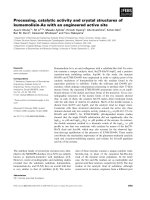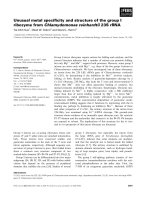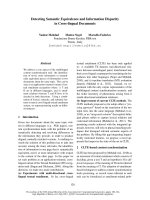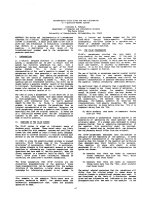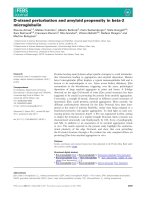Báo cáo khoa học: "Discrepancies between clinical and postmortem diagnoses in critically ill patients: an observational study" pptx
Bạn đang xem bản rút gọn của tài liệu. Xem và tải ngay bản đầy đủ của tài liệu tại đây (79.95 KB, 4 trang )
Available online />Research
Discrepancies between clinical and postmortem diagnoses in
critically ill patients: an observational study
Gavin D Perkins
1
, Danny F McAuley
2
, Sarah Davies
3
and Fang Gao
4
1
Specialist Registrar, Intensive Care Unit, Birmingham Heartlands and Solihull NHS Trust (Teaching), Birmingham Heartlands Hospital, Birmingham, UK
2
Specialist Registrar, Intensive Care Unit, Birmingham Heartlands and Solihull NHS Trust (Teaching), Birmingham Heartlands Hospital, Birmingham, UK
3
Pre-Registration House Officer, Intensive Care Unit, Birmingham Heartlands and Solihull NHS Trust (Teaching), Birmingham Heartlands Hospital,
Birmingham, UK
4
Consultant in Anaesthesia and Intensive Care Medicine, Intensive Care Unit, Birmingham Heartlands and Solihull NHS Trust (Teaching), Birmingham
Heartlands Hospital, Birmingham, UK
Correspondence: F Gao,
Introduction
The postmortem examination has been recognised as an
important tool for confirming the clinical cause of death. The
rate of postmortem examination, however, is declining [1,2].
Technological advances in diagnostic tests and imaging
methods have led to the value of the postmortem examination
being challenged. This, along with concerns surrounding
informed consent and the retention of organs, has made
R129
ICU = intensive care unit.
Abstract
Introduction The autopsy has long been regarded as an important tool for confirming the clinical
cause of death, education and quality assurance. Concerns surrounding informed consent and the
retention of organs have heightened clinicians’ anxieties in requesting permission to perform an
autopsy. The present study was conducted to determine whether the autopsy still has a role to play in
extending knowledge about the cause of death in a group of patients who died while receiving
intensive care.
Method We retrospectively investigated trends in postmortem examination rates and discrepancies
between premortem clinical and postmortem diagnoses in a population of critically ill patients admitted
to a 13 bed, general medical/surgical intensive care unit between January 1998 and June 2001.
Agreement between diagnoses before death and postmortem findings were compared using the
Goldman system.
Results Out of total 636 deaths, 49 (7.7%) underwent postmortem examinations. Of these, 38 (78%)
cases were available for review. We found that postmortem findings were in complete agreement with
predeath diagnoses in fewer than half of the cases (n = 17, 45%). Major missed diagnoses were
present in 15 cases (39%). Myocardial infarction, carcinoma and pulmonary embolism represented the
most frequently missed diagnoses.
Conclusion Postmortem examinations remain a useful tool in confirming diagnostic accuracy and
should be considered in all patients who die in the intensive care unit. Recognition of the diagnoses
missed before death may improve outcome or avoid unnecessary prolongation of life where terminal
disease is present.
Keywords autopsy, clinical diagnosis, critical illness, death, intensive care
Received: 8 July 2003
Accepted: 8 July 2003
Published: 5 September 2003
Critical Care 2003, 7:R129-R132 (DOI 10.1186/cc2359)
This article is online at />© 2003 Perkins et al., licensee BioMed Central Ltd
(Print ISSN 1364-8535; Online ISSN 1466-609X). This is an Open
Access article: verbatim copying and redistribution of this article are
permitted in all media for any purpose, provided this notice is
preserved along with the article's original URL.
Open Access
R130
Critical Care December 2003 Vol 7 No 6 Perkins et al.
clinicians reluctant to request a postmortem examination.
However, previous studies in patients admitted to intensive
care have shown that premortem clinical diagnoses are fre-
quently incorrect, and in up to 27% of patients a treatable
condition that might have altered outcome, had it been recog-
nised, is identified at postmortem examination [3]. The aim of
the present study was to determine the trends in postmortem
examination rate and establish the diagnostic accuracy of
clinical diagnoses in patients who died on an intensive care
unit (ICU) in the UK. We found that, despite a declining post-
mortem examination rate, important discrepancies between
clinical diagnoses before death and postmortem findings
were present in a significant number of cases.
Method
The retrospective review of clinical records and postmortem
results was approved by the local research ethics committee
and HM Coroner for Birmingham District. The study was
undertaken in patients who died and underwent postmortem
examinations after admission to a 13 bed general
medical/surgical ICU in a university affiliated hospital. The
hospital offers most major medical and surgical specialties,
and is a regional centre for thoracic surgery. Neurosurgery,
cardiac surgery and organ transplantation, including bone
marrow transplantation, are not performed at the hospital.
Consent for a hospital postmortem examination is requested
from the relatives at the discretion of the intensive care physi-
cian. When the cause of death was unknown or if the death
was not due to natural causes, the postmortem examination
was performed under the authority of HM Coroner, which
does not require formal consent from the next of kin.
All patients who died between January 1998 and June 2001
were identified from a database of ICU admissions. From this
list, patients who had undergone postmortem examinations
were identified and their medical notes reviewed by two
investigators who were blinded to the postmortem findings.
Both investigators independently assigned clinical causes of
death and then compared their results. Where there was dis-
agreement, the notes were reviewed by both investigators
and a consensus on the cause of death was agreed after dis-
cussion. Both the clinically diagnosed cause of death and
other significant clinical diagnoses were recorded.
The clinical diagnoses were then compared with the findings
at postmortem examination. The comparisons between pre-
mortem and postmortem results were classified as major and
minor discrepancies or as complete agreement, in accor-
dance with the Goldman system [1]. A Goldman class I dis-
crepancy is a missed major diagnosis in which the principle,
underlying causes of death was missed with probable
adverse impact on survival. A Goldman class II discrepancy is
a missed major diagnosis with equivocal impact on survival.
Class III and IV discrepancies refer to minor missed diag-
noses, either unrelated incidental findings or pre-existing
conditions thought not to have contributed directly to the
patient’s death. In class V there is a complete agreement
between clinical and postmortem diagnoses.
Data are expressed as median (interquartile range). Fisher’s
exact test or Mann–Whitney U test was used to compare
patients who underwent postmortem examinations with those
who did not undergo postmortem examinations for continu-
ous and categorical variables as appropriate. P < 0.05 was
considered statistically significant.
Results
During the study period, 2213 patients were admitted to ICU.
Of these 636 patients died, of whom 49 (7.7%) underwent a
postmortem examination. Medical records were not obtain-
able in 11 patients, and therefore 38 patients were included
in the study. Postmortem examinations were requested by the
coroner in 19 cases, with the other 19 postmortem examina-
tions requested by the intensive care medical team. The
intensive care postmortem examination rate progressively
declined over the study period, which reflected a progressive
decline in the overall rate of hospital postmortem examination
(Fig. 1). The median duration of ICU stay for patients who
underwent a postmortem examination was shorter than for
those who did not undergo autopsy (2 [1.2–7.2] versus 2.7
[1–10] days; P = 0.038). Additionally, surgical patients under-
went a postmortem examination more frequently (Table 1).
In 15 (39%) cases there was a new class I or II missed diag-
nosis present. In 10 (26%) cases, knowledge of the post-
mortem findings before death could have altered treatment
and possibly improved outcome (Table 2). Five class II dis-
crepancies were identified: four patients with undiagnosed
malignancy (three thought to have pneumonia, one septic
shock/multiorgan failure) and one patient with pneumonia
Figure 1
Trends in intensive care unit and hospital postmortem examination
rates 1992–2001.
R131
who was receiving appropriate antibiotic treatment for pre-
sumed infection at another site (urinary tract). In contrast, only
17 (45%) cases showed complete agreement between clini-
cal diagnoses and postmortem findings. The remaining six
patients (16%) had only minor additional findings after post-
mortem examination and were classified as Goldman
class III/IV discrepancies.
In patients with class I discrepancies the most frequently
missed diagnosis was myocardial infarction. There was no
relationship between the incidence of major missed diag-
noses and age, Acute Physiology and Chronic Health Evalua-
tion II score, or duration of ICU stay. In addition, there was no
difference in the incidence of missed diagnoses between
hospital postmortem examinations and coroner’s postmortem
examinations.
Discussion
The present study found that the overall rate of postmortem
examination is low and falling. The incidence of 7.7% of all
deaths is much lower than that in other published studies
[3–7]. This finding probably represents the increasing reluc-
tance of many clinicians in the UK to ask for permission to
undertake a postmortem examination. This is further illus-
trated by the finding that a compulsory postmortem examina-
tion requested by the coroner represents 50% of all
postmortem examinations undertaken in the study period,
which is much higher than reported in other series [8]. There
is an urgent need to reverse the decline in the rate of post-
mortem examinations. Despite concerns that relatives will be
unwilling to give permission for a postmortem examination, a
recent study has reported that if they are approached sensi-
tively up to 46% of relatives may agree [9]. Additionally, rec-
ommendations to increase postmortem examination rates can
be successfully implemented and such guidelines should be
put in place [10].
This study has demonstrated poor agreement between the
clinical diagnoses before death and postmortem findings in a
group of patients who died while in the ICU. This finding is
consistent with recent European and American studies that
highlighted that even with modern diagnostic techniques dis-
crepancies between clinical diagnoses and postmortem find-
ings continue to occur [4,6,8,11]. Although it has been
proposed that the duration of stay in the ICU is associated
with the number of unexpected findings at postmortem exami-
nation [6,12], this was not confirmed by the present or previ-
ous studies [4,5,13].
Myocardial infarction represented the most frequent major
missed diagnosis. It is notable that an electrocardiogram was
performed in only 55% of patients undergoing postmortem
examinations at any stage of the ICU stay. This suggests that
the index of suspicion for ischaemic heart disease is inappro-
priately low and should be considered as a diagnostic possi-
bility in the critically ill patient. The incidence of missed
disseminated infection was lower in our patients than in previ-
ous studies [6,8,11,14]. It is possible that the daily multidisci-
plinary microbiology review conducted in our unit may reduce
the possibility of unrecognised occult infection. It may also
reflect a difference in case mix; unrecognised infection is
seen more commonly in immunocompromised patients
[6,11], who are not represented in our patient population. The
finding of undiagnosed carcinoma and pulmonary embolism
is consistent with previous studies emphasizing the impor-
tance of maintaining a high index of suspicion for these diag-
noses in the critically ill [3,5,15]. These findings emphasize
the need for adequate diagnostic algorithms for these
Available online />Table 1
Characteristics of the study population
No postmortem Postmortem
examination examination
Characteristic (n = 587) (n = 49) P
Age (years) 69 (55–75) 69 (62–74) NS
APACHE II score 21 (17–24.5) 22 (19.5–27.5) NS
Predicted mortality (%) 36 (25–53) 42 (29–60.5) NS
Duration of ICU stay 2.7 (1.2–7.2) 2 (1–10) 0.038
(days)
Surgical (%) 47 70 0.01
Shown is a comparison of patients who underwent and those who did
not undergo postmortem examination. Values are expressed as median
(interquartile range). APACHE, Acute Physiology and Chronic Health
Evaluation; ICU, intensive care unit; NS, not significant.
Table 2
Class I discrepancies
Clinical cause of death Postmortem findings
Pneumonia Myocardium infarction
Pneumonia Pulmonary oedema/ischaemic heart disease
Pneumonia Pulmonary embolism
Pneumonia Tracheogastric fistula
Post-oesophagectomy
Aspiration pneumonia Bleeding oesophageal varices
Multiorgan failure
Multiorgan failure Myocardial Infarction
Septic shock Myocardial infarction
Multiorgan failure Bowel infarction
Hepatitis Inferior vena cava thrombosis
Multiorgan failure Sepsis/perirenal abscess
?Lymphoma
Shown are the findings in the 10 patients with class I discrepancies.
Class I discrepancies represent major missed diagnoses in which
knowledge of the postmortem findings might have altered treatment
and/or prolonged survival.
R132
frequently unrecognised conditions to be established in order
to reduce the incidence of missed diagnoses.
Certain limitations of the present study should be recognised.
It is retrospective, and the data for 11 patients were not avail-
able because of incomplete or missing charts. Given that this
is a small study with a low postmortem examination rate, it is
difficult to determine how representative the extent of the new
findings at postmortem examination are of the overall popula-
tion of patients dying in the ICU. Selection bias of patients for
postmortem examination at the discretion of the intensive care
physician might also have influenced the incidence of discrep-
ancies in the patients studied. Given that a postmortem exami-
nation is more usually requested when diagnostic uncertainty
exists, it may be more likely to identify unexpected findings,
leading to a falsely high incidence of missed diagnoses.
However, there is evidence that clinical diagnostic certainty
does not predict postmortem findings, indicating that the inci-
dence of missed diagnosis may in fact be accurate [3,14,15].
Finally, the diagnostic work-up of each individual was not criti-
cally reviewed, and it is possible that variability in investigation
influenced the incidence of missed diagnosis.
The low incidence of postmortem examination in this study
may explain, at least in part, the high incidence of major
missed diagnoses. In a recent study with a high rate of post-
mortem examination [8] the incidence of major missed diag-
noses was low whereas, consistent with our findings, in
studies with a lower rate of postmortem examination [3,6,7]
the incidence of major diagnostic error was higher.
Conclusion
This study found significant discrepancies between clinical
diagnoses before death and postmortem findings. This rein-
forces the importance of the postmortem examination in
detecting otherwise unexpected diagnoses, even in patients
under the close investigation and scrutiny that follows ICU
admission. It should encourage clinicians to remember the
value of the postmortem examination, which should be con-
sidered in every patient who dies in the ICU.
Competing interests
None declared.
References
1. Goldman L, Sayson R, Robbins S, Cohn LH, Bettmann M, Weis-
berg M: The value of the autopsy in three medical eras. N Engl
J Med 1983, 308:1000-1005.
2. Anderson RE, Fox RE, Hill RB: Medical uncertainty and the
autopsy: occult benefits for students. Hum Pathol 1990, 21:
128-135.
3. Blosser SA, Zimmerman HE, Stauffer JL: Do autopsies of criti-
cally ill patients reveal important findings that were clinically
undetected? Crit Care Med 1998, 26:1332-1336.
4. Twigg SJ, McCrirrick A, Sanderson PM: A comparison of post
mortem findings with post hoc estimated clinical diagnoses
of patients who die in a United Kingdom intensive care unit.
Intensive Care Med 2001, 27:706-710.
5. Tai DY, El Bilbeisi H, Tewari S, Mascha EJ, Wiedemann HP,
Arroliga AC: A study of consecutive autopsies in a medical
ICU: a comparison of clinical cause of death and autopsy
diagnosis. Chest 2001, 119:530-536.
6. Mort TC, Yeston NS. The relationship of pre mortem diag-
noses and post mortem findings in a surgical intensive care
unit. Crit Care Med 1999, 27:299-303.
7. Gut AL, Ferreira AL, Montenegro MR: Autopsy: quality assur-
ance in the ICU. Intensive Care Med 1999, 25:360-363.
8. Silfvast T, Takkunen O, Kolho E, Andersson LC, Rosenberg P:
Characteristics of discrepancies between clinical and autopsy
diagnoses in the intensive care unit: a 5-year review. Intensive
Care Med 2003, 29:321-324.
9. Osborn M, Thompson EM: What have we learnt from the Alder
Hey affair? Asking for consent would halt decline in voluntary
necropsies. BMJ 2001, 322:1542-1543.
10. Champ C, Tyler X, Andrews PS, Coghill SB: Improve your hos-
pital autopsy rate to 40–50 per cent, a tale of two towns. J
Pathol 1992, 166:405-407.
11. Roosen J, Frans E, Wilmer A, Knockaert DC, Bobbaers H: Com-
parison of premortem clinical diagnoses in critically iII
patients and subsequent autopsy findings. Mayo Clin Proc
2000, 75:562-567.
12. Thomas MC, Yoston NS: The relationship of pre mortem diag-
noses and post mortem findings in a surgical intensive care
unit. Crit Care Med 1999, 27:299-303.
13. Fernandez-Segoviano P, Lazaro A, Esteban A, Rubio JM, Irure-
tagoyena JR: Autopsy as quality assurance in the intensive
care unit. Crit Care Med 1988, 16:683-685.
14. Podbregar M, Voga G, Krivec B, Skale R, Pareznik R, Gabrscek L:
Should we confirm our clinical diagnostic certainty by autop-
sies? Intensive Care Med 2001, 27:1750-1755.
15. Berlot G, Dezzoni R, Viviani M, Silvestri L, Bussani R, Gullo A:
Does the length of stay in the intensive care unit influence the
diagnostic accuracy? A clinical-pathological study. Eur J
Emerg Med 1999, 6:227-231.
Critical Care December 2003 Vol 7 No 6 Perkins et al.
Key messages
• Postmortem rates after death on ITU were low
• Major missed diagnoses were present in 39% of
patients in this study
• Myocardial infarction, carcinoma and pulmonary
embolism were the most frequently missed diagnoses
• Clinicians should review their threshold for requesting
a postmortem following death on the ITU
